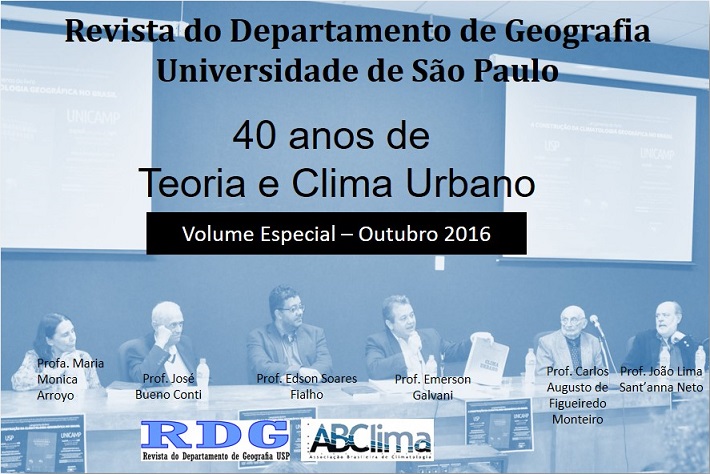COLD WAVES AND RESPIRATORY DISEASE: ANALYSIS FROM CLIMATE VULNERABILITY PERSPECTIVE
DOI:
https://doi.org/10.11606/rdg.v0ispe.118949Keywords:
Ondas de frio, Enfermidades respiratórias, Vulnerabilidade, Índices climáticos.Abstract
Different ways of geographic space production by social groups deflagrates different repercussions of climate dynamics by atmospheric elements. In this context, this article aims to approach the relationship between extreme events and vulnerability to respiratory diseases from an exploratory study of cold waves in Piracicaba – São Paulo - Brazil. Five different climatic indices were applied to minimum temperature data from an INMET station. 1998-2014-respiratory diseases hospitalization data from DataSUS were correlated comparatively to cold waves given in each technique. Results indicate increases in cold waves occurrence in winter months, especially in the climatological normal period (1961-1990) in comparison to the recent period (1991-2014). Between the different techniques, the cold waves number is uneven and varies from 72 cold waves (CSDI-OMM index) to 329 (IPCC index) in the same period. Vulnerability analysis demonstrated 0-9 and 80+ years old people represents the more affected public for respiratory diseases, representing more than 50% of all the hospitalizations (21,115). In general, the winter months in which presented more cold waves totals also presented more hospitalizations, especially in July, with more than 200 hospitalizations. The results show that temperature (cold wave) is not the principal responsible to respiratory diseases deflagration. There is the need to approach extreme event and vulnerability concepts to a sociospatial analysis of respiratory diseases production, in which the climatic elements are only one factor in the diseases deflagration.Downloads
Download data is not yet available.
Downloads
Published
2016-10-24
Issue
Section
Artigos
License
Autores que publicam nesta revista concordam com os seguintes termos:
- Autores mantém os direitos autorais e concedem à revista o direito de primeira publicação, com o trabalho simultaneamente licenciado sob a Licença Creative Commons Attribution BY-NC-SA que permite o compartilhamento do trabalho com reconhecimento da autoria e publicação inicial nesta revista.
- Autores têm autorização para assumir contratos adicionais separadamente, para distribuição não-exclusiva da versão do trabalho publicada nesta revista (ex.: publicar em repositório institucional ou como capítulo de livro), com reconhecimento de autoria e publicação inicial nesta revista. A licença adotada enquadra-se no padrão CC-BY-NC-SA.
- Autores têm permissão e são estimulados a publicar e distribuir seu trabalho online (ex.: em repositórios institucionais ou na sua página pessoal) a qualquer ponto antes ou durante o processo editorial, já que isso pode gerar alterações produtivas, bem como aumentar o impacto e a citação do trabalho publicado (Veja O Efeito do Acesso Livre).
How to Cite
Fante, K. P., & Armond, N. B. (2016). COLD WAVES AND RESPIRATORY DISEASE: ANALYSIS FROM CLIMATE VULNERABILITY PERSPECTIVE. Revista Do Departamento De Geografia, spe, 145-159. https://doi.org/10.11606/rdg.v0ispe.118949


